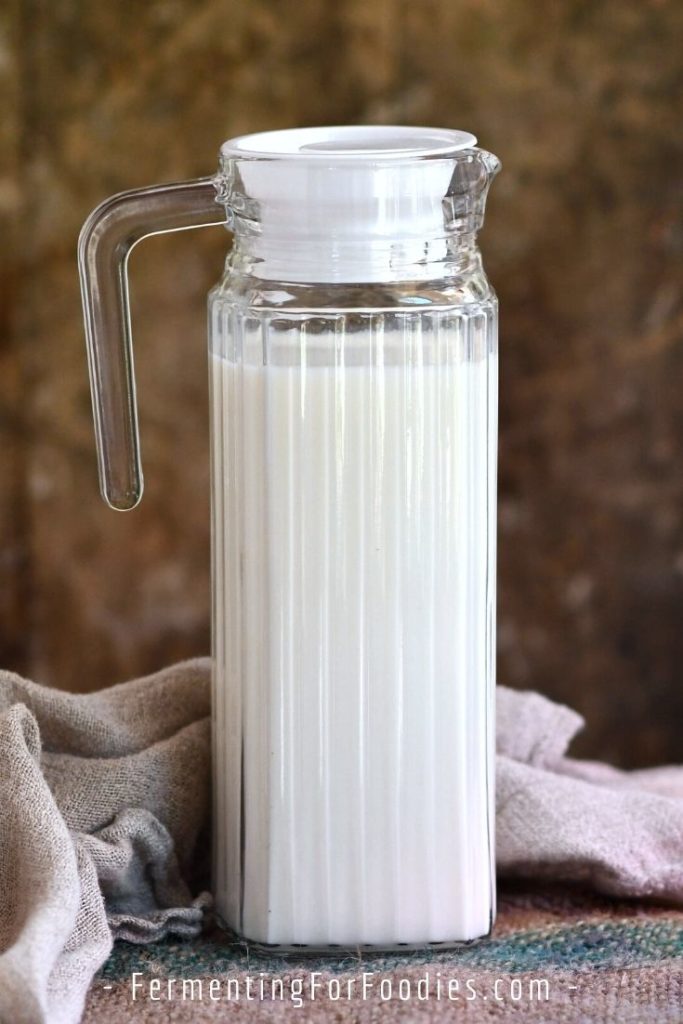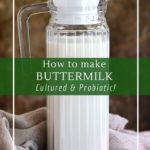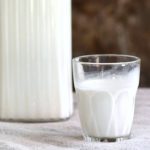Cultured buttermilk is more than just soured milk used for baking. It is a delicious probiotic beverage with a slightly cottage cheese-like flavor.

Buttermilk is traditionally made with a mesophilic (room temperature-loving) culture, which means it is REALLY easy to make! Homemade buttermilk is a simple and delicious alternative to homemade yogurt and milk kefir. Perfect for anyone looking to get more probiotics into their diet!
Types of Buttermilk
There are three basic types of buttermilk:
- Leftover from churning butter: Traditionally buttermilk was the leftover liquid from churning butter. It’s really fun and easy to make homemade butter. The resulting buttermilk is quite thin and slightly sweet. My kids love to drink it! But it’s not at all the same as the buttermilk you find in the grocery store.
- Soured milk: Many how-to-make buttermilk recipes involve mixing milk with lemon juice or white vinegar to create soured milk that is really only good for baking. It lacks all the flavor and probiotics that come with store-bought cultured buttermilk.
- Cultured buttermilk is made by fermenting milk with a bacteria culture. Not only is REALLY easy to make but it’s also packed full of flavor and probiotics!
Where to find culture for homemade buttermilk
The hardest part of making buttermilk is finding a good starter culture!
While most (all?) brands of buttermilk that you find in the grocery store have been cultured, it doesn’t mean that they still have an active culture. If you’re new to making buttermilk, you may need to experiment with a few different brands to find one that has an active culture.
Here are a few things to look for:
- Smaller dairies
- Organic dairies
- Avoid short expiry dates (you want the freshest culture available)
In Ireland we used Cuinneog, and in Canada, we use Avalon. Alternatively, you can buy packets of buttermilk culture online.
Saving buttermilk culture
Once you have a reliable culture, you can make buttermilk over and over again. The only trick is to make sure that you maintain a vigorous culture. Here is how to save your culture for future batches of buttermilk:
- Buttermilk needs to be recultured every week to remain vigorous. That’s a great option if you’re using buttermilk as a homemade yogurt alternative.
- Alternatively, freeze 1/2 cup portions of buttermilk for future batches. It will remain vigorous for at least 4 months in the deep freezer.
How To Use Cultured Buttermilk
Cultured buttermilk is a delicious way to get a dose of probiotics. It is sweeter than yogurt and kefir. In Brittany, fermented lait ribot is more popular than milk!
Here are a few ways to enjoy cultured buttermilk:
- Buttermilk is perfect for providing acidity in soda bread, pancakes, and muffins.
- It can be served as a mild-tasting yogurt. To make thick, yogurt-like buttermilk, heat the milk like you would for yogurt, to denature the proteins. Then let it cool to room temperature before stirring in the culture. There’s no need to use a yogurt maker because it prefers temperatures around 72 F (22 C)!
- Fermented buttermilk is perfect for smoothies.
- We use it instead of milk on our cereal in the morning. (I’m not even sure my kids know what cereal tastes like without fermented dairy)!
- Culturing milk with buttermilk is a great way to preserve milk while camping or traveling. It doesn’t need to be kept cool.
- Buttermilk can also be used to make sour cream! It’s not the same culture as traditional sour cream, but it’s close enough.
- Did you know that buttermilk can be used as a culture to make cottage cheese? It’s actually the traditional way for farmers to make cheese. It was the perfect option since the culture was readily available and didn’t need to be heated.
Cultured Buttermilk
Cultured buttermilk is a flavorful and probiotic drink. It is a delicious substitute for yogurt and perfect for baking! See the sections above for advice on where to find the culture in your grocery store and how to maintain it so you can keep making buttermilk!
- Prep Time: 5 minutes
- Total Time: 5 minutes
- Yield: 2 1/2 cups 1x
- Category: Beverage
- Method: Fermented
- Cuisine: Traditional
- Diet: Vegetarian
Ingredients
- 2 cups milk (whole or skim)
- 1/2 cup cultured buttermilk
Instructions
- Mix the buttermilk and milk in a clean glass jar.
- Place the lid on the jar and leave the jar to ferment on the counter for 4-12 hours (see notes). Buttermilk doesn’t have a yeast-based culture so a tight-fitting lid is fine. Buttermilk thickens best at temperatures of around 68F to 86F (20C to 30C). Expect it to take a bit longer if it’s colder than that.
- Taste the buttermilk to determine when it is done. It should taste slightly sour and a bit like cottage cheese. The first time you make buttermilk, it may take a little longer (up to 24 hours) to achieve a nice flavor. It will depend on the quality of your buttermilk culture. However, once you’ve established your culture, it should ferment within 4 to 8 hours.
- Store in the refrigerator and use it within 2 weeks.
Notes
- If the buttermilk hasn’t soured within 24 hours, then the culture wasn’t alive and vigorous. If this happens, then I recommend trying a different brand. See the section above for more information on finding good buttermilk cultures.
- Save a bit of your buttermilk to make future batches! See the section above for details on how to keep a vigorous culture.



Help! First time making and it took for ever to thicken. House no doubt not warm enough too. Tried during the day to warm up. Smell was delicious and sweet. Just seemed to be thickening and thought I would leave it out just a bit longer. About 1 – 1 1/2 hours later curdled. Separated. Maybe not as sweet. I assume heading to a vinegary state. Is it still okay? Still has a sweet smell. I was so excited! Hope I don’t have to start over?
The first time you culture buttermilk, it takes a while to kick start (depending on the strength of the culture.) It sounds fine, just a little strongly cultured. It can still be used to make your next batch of buttermilk. And use it for baking if you find it too strong tasting. Enjoy!
This sounds fun and delicious. I want to make sure I understand the process. First I would have to buy the culture you recommend. (As an aside, I see it consists of five packets. Once I have an active culture would I need the other four?) After making the first batch of culture, I would reserve half a cup or a cup for future batches. I could make those any time up to two weeks after the previous batch. Do I understand the process correctly? Thanks.
Hi Barry,
If you are buying the packets of culture, then I recommend saving the extra 4 packets and reculture the buttermilk with your saved culture. Then you can always start with a fresh packet later on. Sometimes cultures will change slightly over time. So I usually only reuse a culture for a few months before restarting with a fresh culture. That’s because I also culture milk kefir… and it tends to start to take over after a little while. 🙂
Cheers, Emillie
Hello, Here in Ireland in the local supermarket they offer, cultured or natural buttermilk. Neither seem to mention probiotics on the package. Which is best to purchase f=to get the benefits of probiotics ? Thank You.
Hi Michael, I used to live in Maynooth, so I know a bit about Irish buttermilk! I really liked Cuinneog. It had a strong culture that I even used to make cottage cheese. Good luck!
My Mom made homemade buttermilk that had a wonderful taste all it’s own. It was like taste bud tweaking like a very slight Dill pickle pucker. Absolutely delicious. I going to find the culture you mentioned and give it a try! Loved her buttermilk!
Buttermilk is delicious! Good luck finding a culture.
This was awesome, though mine was a bit thick.
Try culturing for a shorter time. It shouldn’t get too thick. Cheers!
I made some cultured butter a couple weeks ago and used the resulting buttermilk to culture a batch of buttermilk. it was so thick and creamy. I’ve been reculturing batches from that first batch ever since! its wonderful. I use it for pancake/waffles and biscuits and scones.. i can’t convince my kids to drink it yet- maybe a berry smoothie?! Most recipes i see call for a tablespoon of cultured buttermilk per cup of milk, i notice that you used much more buttermilk, (like i did), and it seems to make it much thicker than the store bought buttermilk! great recipe and instructions! thank you!
Glad this recipe worked for you! I like nice thick buttermilk (and cultured butter, yum!) If you want to skip the trouble of mixing a smoothie, maybe try mixing a bit of juice into the buttermilk for your kids? I find a little bit of extra sweetness helps. Cheers!
I’m loving all this information. One suggestion: I make a half-gallon of whole-milk buttermilk at a time and use 1/2 cup buttermilk to a half gallon of milk. It works out to one TBSP cultured buttermilk per cup of room-temp milk. It always comes out thick and creamy. The same ratio should work with lower fat milks.
That sounds like you have a really strong and reliable buttermilk culture. 🙂 Most store-bought buttermilk isn’t that great at culturing… so using a higher ratio is more reliable. And you are correct, it’s the same for whole milk or low-fat milk. Cheers, Emillie